Two exhibitions worth checking out are now on display in New York City:
Design with the Other 90%: CITIES, organized by the Cooper-Hewitt yet exhibited at the United Nations, runs until January 9, 2012; and
Civic Action: A Vision for Long Island City is on display at the Noguchi Museum until April 22, 2012. The first "features sixty projects, proposals, and solutions that address the complex issues arising from the unprecedented rise of informal settlements in emerging and developing economies," while the second exhibits "new approaches to development in this area of Long Island City [where the Noguchi Museum and
Socrates Sculpture Park are located] that [artists Isamu] Noguchi and [Mark] di Suvero helped to shape." In the number of ways that each is different -- in terms of population, geography, diversity, etc. -- they are also very similar, especially in how bottom-up approaches are embraced for urban change. Some thoughts on my visits to each exhibition follow.
Design with the Other 90%: CITIES: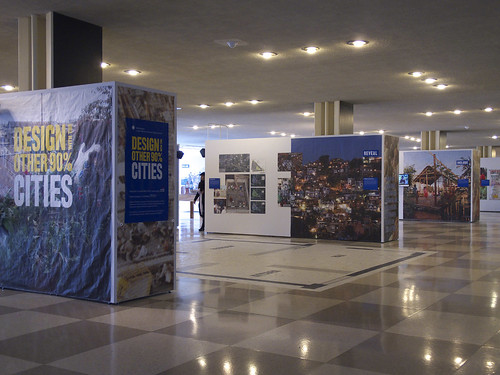
Design with the Other 90%: CITIES is a follow up to the Cooper-Hewitt's 2007 exhibition
Design for the Other 90%, which presented "cost-effective ways to increase access to food and water, energy, education, healthcare, revenue-generating activities, and affordable transportation for those who most need them." In that exhibition the canvas was broad, looking at design from the small and the personal (the cover of the
companion book shows a tool for drinking from standing water) to the large and infrastructural. In the successor it's clear that cities are the focus, yet this does not mean that small interventions are not to be found; instead they are situated within the context of the growing urban population -- over half of the earth's roughly 7 billion people live in cities, close to one billion in informal settlements.

The exhibition is structured into six themes -- Exchange, Reveal, Adapt, Include, Prosper and Access -- which are inserted into the public lobby of the United Nations Visitor Center (the Cooper-Hewitt is closed until 2013 for
renovation). Given the efforts of the UN towards transforming informal settlements and their residents, especially through its
Habitat and
Development entities, it makes perfect sense for the exhibition to be housed at the UN, which is actually undergoing
its own renovation. A series of parallel walls sit perpendicular to the flow of traffic, with plenty of room between the walls for models and full-scale prototypes; the latter are some of the best aspects of the exhibition.
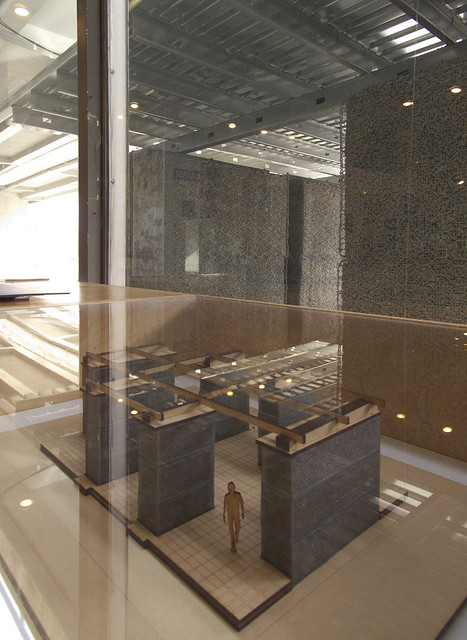
A couple architectural projects that are illustrated via full-scale mock-ups include "
Make a House Intelligent" by Arturo Ortiz Struck and others (above) and the "
10x10 Sandbag House" by architect Luyanda Mpahlwa (below). The first responds to the necessity in parts of Mexico City to occupy a lot within 30 days; the architects designed a flexible system of sand, concrete blocks, gabions, and steel beams, which can be erected by five people in less than a week. The second consist of two-story, wood-frame houses with sandbag infill that are replacing dwellings of corrugated metal and scrap materials in Cape Town, South Africa's Mitchell's Plain township. In each case an understanding of the construction that comes from the mock-ups increases an appreciation of the designs and applications.
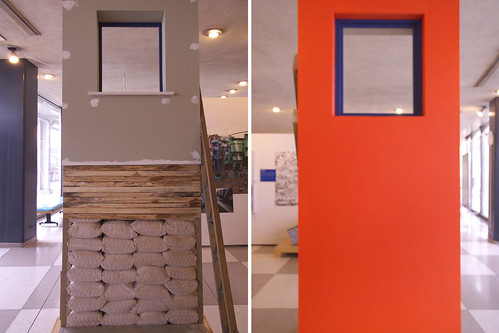
On a much larger scale is the "
Medellín Metrocable and Northeast Integral Urban Project," which also addresses informal housing but does it differently than the two construction schemes above. Instead of tackling housing, the project focuses on access, such that by improving the connections between informal settlements and other parts of the city, "an inclusive metropolis" is created. While this is a top-down approach requiring government spending to build on a large scale, it has as much merit as bottom-up approaches that enable residents to improve their immediate living conditions. Ultimately the two types of development need to happen -- perhaps converging at some ideal point -- for informal settlements to lift themselves up above their origins. The exhibition implies that even though these and other designs are site specific they offer lessons that can be applied in other places in need.
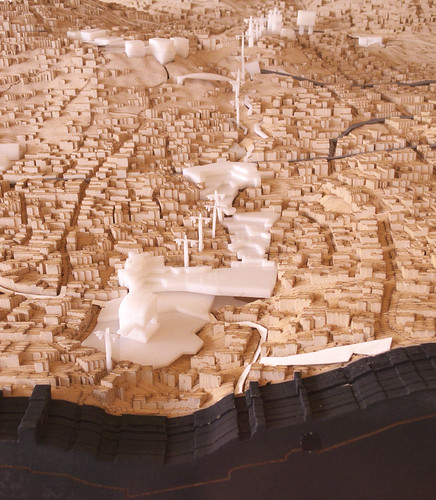
While Design with the Other 90%: CITIES is closing soon, it is "
available for travel" in the US and abroad from February 2012, so it may be coming to a city near you. Regardless,
a catalog accompanies the exhibition.
Civic Action: A Vision for Long Island City: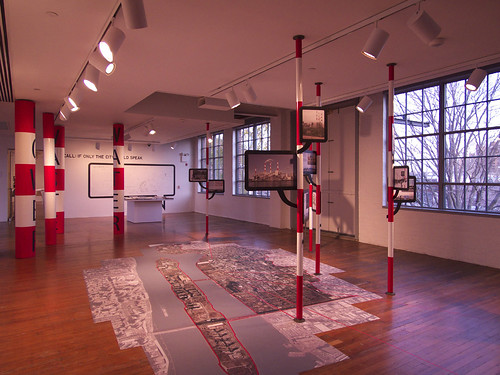
Across the East River, inside the Noguchi Museum in Long Island City, Queens, sits the
Civic Action exhibition that presents ideas for transforming the neighborhood around the museum and the nearby Socrates Sculpture Park. The two arts institutions collaborated to develop the initiative, in response to new development, rezoning, and an increased residential population. I live nearby in Astoria, but my neighborhood is primarily residential with a little light industry on certain streets; the area around Noguchi and Socrates is much different, marked by more substantial industrial buildings, big box retail, large open spaces, and the
Big Allis power generator. The striped stacks of the last are obviously a point of departure for artist
Mary Miss and her team's installation, pictured above and below.
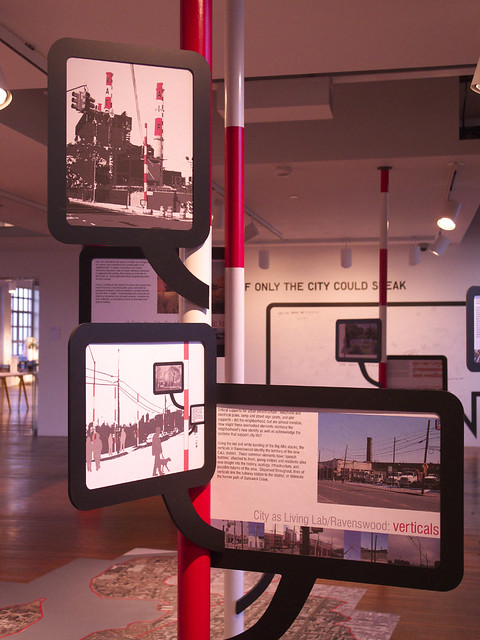
Miss's "City as a Living Laboratory" uses floor-to-ceiling poles and tubes to provide a strong visual image and to structure displays for the various phases of the plan: 1-Using the Big Allis stacks as beacons to display the city's energy usage; 2-Repurposing utility poles and other vertical infrastructure in Big Allis-like banding to let visitors know about the new "Research Zone" in the city; 3-Re-purposing everyday elements in the area, such as scaffolding, blank walls of industrial buildings, and trailer-truck containers for, respectively, green walls, park slices, and incubator studios for developing ideas and projects about the city. I'll admit that this project in particular made me see the context around the Noguchi in a new light, as the trucks and other elements seemed to stand out more than normal after my visit. Miss's ideas are the most digestible, stemming from the striped branding and the simple yet thoughtful graphics and composition of the installation.
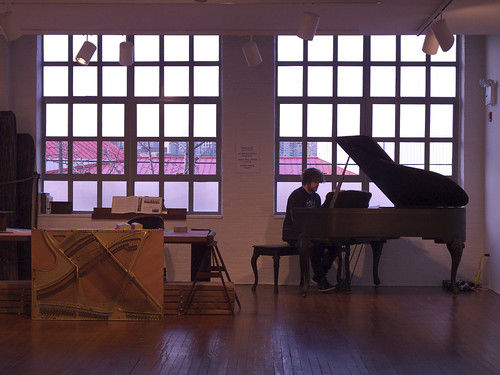
On the other hand, George Trakas's "Shoreline Walk" is a great idea -- bringing the community to the water's edge -- that is varied and sporadic in execution. The installation is a mix of mapping, history, and music (above) that offers suggestions for knitting the various plots along the waterfront, including Big Allis. This is not surprising to me, as Trakas is responsible for the
Nature Walk at the Newtown Creek Wastewater Treatment Plant (PDF link) in Greenpoint, Brooklyn. There Trakas wends the walk past the industrial infrastructure and directly to the water, turning it again 90 degrees to a path planted with native trees. It is a good illustration (and worth a visit) of how connecting to the water can be achieved in a small amount of space and from a point removed from the water.
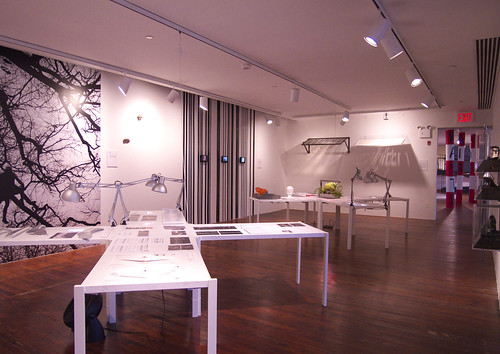
Natalie Jeremijenko's "UP_2_U" spreads itself across a couple spaces with a variety of ideas on the walls and on tables (above) as part of her "Environmental Health Clinic Civic Action team." This installation reminded me of the Architectural League's
Toward the Sentient City, because both integrate technology into the city in various ways. But Jeremijenko proposes more than "real-time 'smart-city' technologies...to close feedback loops and radically upgrade environmental health;" she also proposes fairly low-tech solutions, like "AgBags," that would hang from buildings to "create arable land for new edibles." In the case of the latter I like how it was presented in front of one of the museum's windows (below). The rest of the installation is also thoughtfully put together, be it the X-shaped tables, wall graphics, or the shadows cast by the solar awnings (above).

The most minimal installation is easily "GreenWay and Community Kitchen" by Rirkrit Tiravanija and team (below images). Their plan proposes to re-pave Broadway in Queens, which runs from the N/Q elevated station to Socrates Sculpture Park one block south of the Noguchi. This street is documented in the Ed Ruscha-esque photomontage below, but it is presented as a
serrated composition instead of flatly, which emphasizes the smaller pockets of space that can then be closed off for special events, such as markets or film screenings.

Tiravanja's project also features the most overt piece of architecture, a Community Kitchen that would initially be placed in Socrates Sculpture Park. The design (below) is a scaled-up version of Noguchi's
YA2 table lamp, a point of reference that links two arts institutions which people might not otherwise see as working together. In that regard it makes sense that Socrates will host the exhibition after it closes at the Noguchi in April next year.
 Conclusion:
Conclusion:These two exhibitions may vary in a number of ways -- 90% is international, Civic is local; 90% presents realized examples, Civic is all speculation; 90% comes from various authors, Civic is only four teams -- but they share many qualities, particularly placing a value on creative design for addressing urban problems and prioritizing bottom-up initiatives for making change. Each exhibition requires slow, in-depth visits to best appreciate and understand the various ways of intervening. The Cooper-Hewitt show benefits from an accompanying catalog, so here's hoping the Noguchi and Socrates assemble the ideas from their show in print form, both as a way to share the projects to a larger audience and to help instigate change in their own backyard.
 [Images: A "living neon sign" made of bioluminescent bacteria; via UC San Diego].
[Images: A "living neon sign" made of bioluminescent bacteria; via UC San Diego]. [Image: Bioluminescent billboards by Liam Young].
[Image: Bioluminescent billboards by Liam Young]. [Image: "From Seismic Arrays on Drifting Ice Floes: Experiences From Four Deployments in the Arctic Ocean" by C. Läderach and V. Schlindwein, from
[Image: "From Seismic Arrays on Drifting Ice Floes: Experiences From Four Deployments in the Arctic Ocean" by C. Läderach and V. Schlindwein, from  [Images: "From Seismic Arrays on Drifting Ice Floes: Experiences From Four Deployments in the Arctic Ocean" by C. Läderach and V. Schlindwein, from
[Images: "From Seismic Arrays on Drifting Ice Floes: Experiences From Four Deployments in the Arctic Ocean" by C. Läderach and V. Schlindwein, from  [Image: Drift Station Bravo postage cancellation mark, via
[Image: Drift Station Bravo postage cancellation mark, via 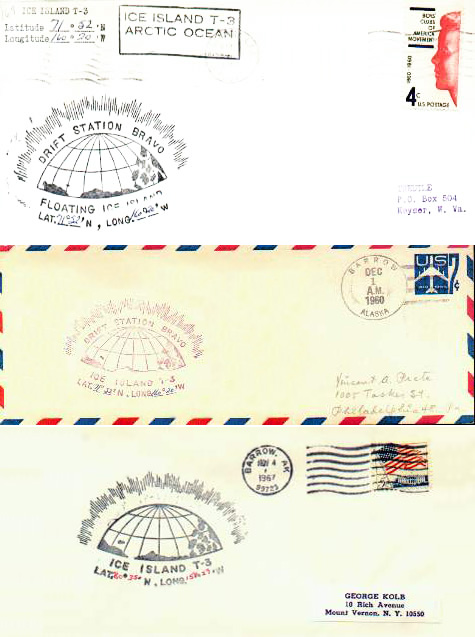 [Image: Letters postmarked from Drift Station Bravo, via
[Image: Letters postmarked from Drift Station Bravo, via 
 [Images: Postal marking and a letter from Drift Station Bravo, via
[Images: Postal marking and a letter from Drift Station Bravo, via 
 [Images:
[Images: 

 Lets backtrack a bit. The Pompidou Centre (or Beaubourg as it is known) was opened in 1977, designed by famed Italian architect Renzo Piano along with Richard and Su Rogers and Gianfranco Franchini. The award winning building has been turning heads ever since.
Lets backtrack a bit. The Pompidou Centre (or Beaubourg as it is known) was opened in 1977, designed by famed Italian architect Renzo Piano along with Richard and Su Rogers and Gianfranco Franchini. The award winning building has been turning heads ever since. Paris, that is central Paris, is not known for its modern architecture so the very existence of this building is surprising. The size is immense, however the scale is broken down into bits by the exposed structure and services which bring it down to a city and even human scale. Now that the colors have faded over the years (believe it or not) it blends a little easier into the charming French gray the city is known for.
Paris, that is central Paris, is not known for its modern architecture so the very existence of this building is surprising. The size is immense, however the scale is broken down into bits by the exposed structure and services which bring it down to a city and even human scale. Now that the colors have faded over the years (believe it or not) it blends a little easier into the charming French gray the city is known for. Love it or hate it, the building is much beloved and locals crowd the adjacent square on weekends, many calling it "Paris's living room".
Love it or hate it, the building is much beloved and locals crowd the adjacent square on weekends, many calling it "Paris's living room". 

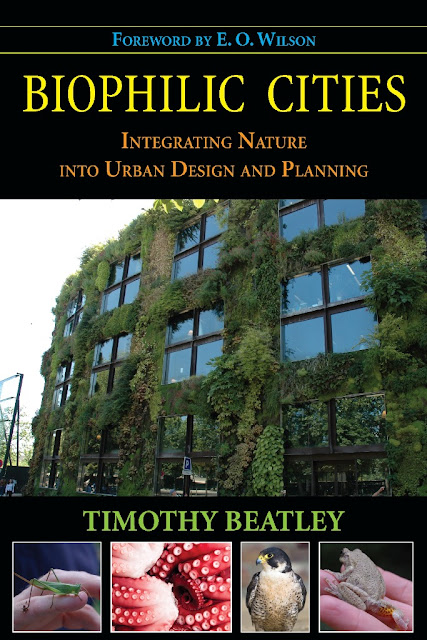



 The beautiful and large apartment is obviously the home of scholars as books are the focus as opposed to the art which I expected.
The beautiful and large apartment is obviously the home of scholars as books are the focus as opposed to the art which I expected.  Built in shelves cover many of the walls while still more books are piled on numerous other surfaces. I felt right at home as I can relate to this in my own apartment!
Built in shelves cover many of the walls while still more books are piled on numerous other surfaces. I felt right at home as I can relate to this in my own apartment!
 This final configuration wasn't exactly their original plan for the space, as evidenced by this watercolor. Originally they had planned on a more architectural solution but over time they abandoned it for a lighter touch which I think makes the space feel larger.
This final configuration wasn't exactly their original plan for the space, as evidenced by this watercolor. Originally they had planned on a more architectural solution but over time they abandoned it for a lighter touch which I think makes the space feel larger. Bookshelves continue in the alcove off the living room which contains their reading desk for the hours of research they put into their pieces.
Bookshelves continue in the alcove off the living room which contains their reading desk for the hours of research they put into their pieces. A small den off the alcove contains the tv, computer desk and their collection of architectural etchings.
A small den off the alcove contains the tv, computer desk and their collection of architectural etchings.

 I'Yo Ho! my boys," said Fezziwig. "No more work to-night! Christmas Eve, Dick! Christmas, Ebenezer! Let's have the shutters up!" cried old Fezziwig with a sharp clap of his hands, "before a man can say JackRobinson. . . ."
I'Yo Ho! my boys," said Fezziwig. "No more work to-night! Christmas Eve, Dick! Christmas, Ebenezer! Let's have the shutters up!" cried old Fezziwig with a sharp clap of his hands, "before a man can say JackRobinson. . . ."  Clear away! There was nothing they wouldn't have cleared away, or couldn't have cleared away with old Fezziwig looking on. It was done in a minute. Every movable was packed off, as if it were dismissed from public life forevermore; the floor was swept and watered, the lamps were trimmed, fuel was heaped upon the fire; and the warehouse was as snug, and warm, and dry, and bright a ballroom as you would desire tosee on a winter's night.
Clear away! There was nothing they wouldn't have cleared away, or couldn't have cleared away with old Fezziwig looking on. It was done in a minute. Every movable was packed off, as if it were dismissed from public life forevermore; the floor was swept and watered, the lamps were trimmed, fuel was heaped upon the fire; and the warehouse was as snug, and warm, and dry, and bright a ballroom as you would desire tosee on a winter's night. In came a fiddler with a music book, and went up to the lofty desk and made an orchestra of it and tuned like fifty stomach aches. In came Mrs. Fezziwig, one vast substantial smile. In came the three Misses Fezziwig, beaming and lovable. In came the six followers whose hearts they broke. In came all the young men and women employed in the business. In came the housemaid with her cousin the baker. In came the cook with her brother's particular friend the milkman. In came the boy from over the way, who was suspected of not having board enough from his master, trying to hide himself behind the girl from next door but one who was proved to have had her ears pulled by her mistress; in they all came, any-how and every-how. Away they all went, twenty couple at once; hands half round and back again the other way; down the middle and up again; round and round in various stages of affectionate grouping, old top couple always turning up in the wrong place; new top couple starting off again, as soon as they got there; all top couples at last, and not a bottom one to help them.
In came a fiddler with a music book, and went up to the lofty desk and made an orchestra of it and tuned like fifty stomach aches. In came Mrs. Fezziwig, one vast substantial smile. In came the three Misses Fezziwig, beaming and lovable. In came the six followers whose hearts they broke. In came all the young men and women employed in the business. In came the housemaid with her cousin the baker. In came the cook with her brother's particular friend the milkman. In came the boy from over the way, who was suspected of not having board enough from his master, trying to hide himself behind the girl from next door but one who was proved to have had her ears pulled by her mistress; in they all came, any-how and every-how. Away they all went, twenty couple at once; hands half round and back again the other way; down the middle and up again; round and round in various stages of affectionate grouping, old top couple always turning up in the wrong place; new top couple starting off again, as soon as they got there; all top couples at last, and not a bottom one to help them. When this result was brought about the fiddler struck up "Sir Roger de Coverley." Then old Fezziwig stood out to dance with Mrs. Fezziwig. Top couple, too, with a good stiff piece of work cut out for them; three or four and twenty pairs of partners; people who were not to be trifled with; people who would dance and had no notion of walking.
When this result was brought about the fiddler struck up "Sir Roger de Coverley." Then old Fezziwig stood out to dance with Mrs. Fezziwig. Top couple, too, with a good stiff piece of work cut out for them; three or four and twenty pairs of partners; people who were not to be trifled with; people who would dance and had no notion of walking. But if they had been thrice as many, oh, four times as many, old Fezziwig would have been a match for them, and so would Mrs. Fezziwig. As to her, she was worthy to be his partner in every sense of the term. If that's not high praise, tell me higher and I'll use it. A positive light appeared to issue from Fezziwig's calves. They shone in every part of the dance like moons. You couldn't have predicted at any given time what would become of them next. And when old Fezziwig and Mrs. Fezziwig had gone all through the dance, advance and retire; both hands to your partner, bow and courtesy, corkscrew, thread the needle, and back again to your place; Fezziwig cut so deftly that he appeared to wink with his legs, and came upon his feet again with a stagger.
But if they had been thrice as many, oh, four times as many, old Fezziwig would have been a match for them, and so would Mrs. Fezziwig. As to her, she was worthy to be his partner in every sense of the term. If that's not high praise, tell me higher and I'll use it. A positive light appeared to issue from Fezziwig's calves. They shone in every part of the dance like moons. You couldn't have predicted at any given time what would become of them next. And when old Fezziwig and Mrs. Fezziwig had gone all through the dance, advance and retire; both hands to your partner, bow and courtesy, corkscrew, thread the needle, and back again to your place; Fezziwig cut so deftly that he appeared to wink with his legs, and came upon his feet again with a stagger. When the clock struck eleven the domestic ball broke up. Mr. and Mrs. Fezziwig took their stations, one on either side of the door, and shaking hands with every person individually, as he or she went out, wished him or her a Merry Christmas!
When the clock struck eleven the domestic ball broke up. Mr. and Mrs. Fezziwig took their stations, one on either side of the door, and shaking hands with every person individually, as he or she went out, wished him or her a Merry Christmas!
 [Image: Downtown Reno on a Saturday night with people queuing up to climb the BaseCamp wall; photo by BLDGBLOG].
[Image: Downtown Reno on a Saturday night with people queuing up to climb the BaseCamp wall; photo by BLDGBLOG]. [Image: The wall; photo by BLDGBLOG].
[Image: The wall; photo by BLDGBLOG]. [Image: The wall; photo by BLDGBLOG].
[Image: The wall; photo by BLDGBLOG]. [Image: The
[Image: The  [Image: The
[Image: The  [Images: An artificial ice structure by
[Images: An artificial ice structure by 










